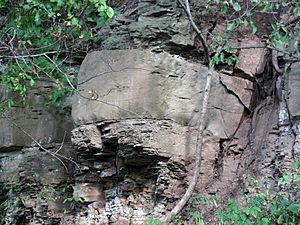Dunkard Group facts for kids
Quick facts for kids Dunkard GroupStratigraphic range: Pennsylvanian-Permian |
|
|---|---|

Sandstone (Greene Formation, Lower Permian; Monroe County, Ohio)
|
|
| Type | Group |
| Sub-units | Greene Formation, Waynesburg Formation, Washington Formation |
| Underlies | Igneous intrusives |
| Overlies | Monongahela Formation |
| Lithology | |
| Primary | Shale, sandstone, siltstone, coal |
| Other | Limestone |
| Location | |
| Region | |
| Country | |
The Dunkard Group is a special collection of rocks found in parts of Ohio, Pennsylvania, West Virginia, and Maryland. These rocks formed a very long time ago, during the Early Permian period. That's about 299 to 252 million years ago! What makes the Dunkard Group unique is that it's one of the only places east of the Mississippi River where you can find rocks from the Permian period. In fact, in Ohio, these are the youngest rocks you can see on the surface.
What is the Dunkard Group?
The Dunkard Group is made up of different kinds of rocks. You can find red and green shale (a soft, layered rock), siltstone (like hardened mud), and sandstone (rock made from sand).
Sometimes, there are thin layers of limestone (rock made from shells and bones) and thin layers of coal (a black rock that can burn). At the very bottom of the Dunkard Group, there's a thick layer of white conglomerate sandstone. This is a type of sandstone with rounded pebbles mixed in.
In Maryland, this rock layer can be more than 200 feet thick!
What fossils are found in the Dunkard Group?
Scientists have found many interesting fossils in the Dunkard Group. These fossils are similar to ones found in Texas and Oklahoma from the same time period. They tell us about the ancient animals that lived here millions of years ago.
Here are some of the creatures whose fossils have been discovered:
- Dimetrodon (an ancient reptile with a sail on its back)
- Ctenospondylus (another type of ancient reptile)
- Archaeothyris (one of the earliest reptiles)
- Edaphosaurus (a plant-eating reptile with a sail)
- Eryops (a large amphibian that lived in water and on land)
- Xenacanthus (an ancient shark)
- Ophiacodon (an early reptile)
- Diploceraspis (an amphibian with a boomerang-shaped head)
- Diplocaulus (another amphibian with a boomerang-shaped head)
- Baldwinonus
- Protorothyris
- Diadectes (a large, plant-eating reptile-like amphibian)
- Isodectes
- Sagenodus (an ancient lungfish)
- Brachydectes
- Phlegethontia (a snake-like amphibian)

